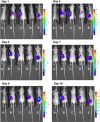Characterization and real-time imaging of gene expression of adenovirus embedded silk-elastinlike protein polymer hydrogels
- PMID: 18763804
- PMCID: PMC2638171
- DOI: 10.1021/mp800054w
Characterization and real-time imaging of gene expression of adenovirus embedded silk-elastinlike protein polymer hydrogels
Abstract
Transient expression levels, vector dissemination and toxicities associated with adenoviral vectors have prompted the usage of matrices for localized and controlled gene delivery. Two recombinant silk-elastinlike protein polymer analogues, SELP-47K and SELP-415K, consisting of different lengths and ratios of silk and elastin units, were previously shown to be injectable hydrogels capable of matrix-mediated controlled adenoviral gene delivery. Reported here is a study of spatiotemporal control over adenoviral gene expression with these SELP analogues in a human tumor xenograft model of head and neck cancer using whole animal imaging. Real-time images of viral expression levels indicate that polymer concentration and polymer structure are predominant factors that affect viral release and, thus, viral transfection. Decrease in polymer concentration and increase in polymer elastin content results in greater release, probably due to changes in the network structure of the hydrogel. To better understand this relationship, macro- and microstructural properties of the hydrogels were analyzed using dynamic mechanical analysis (DMA) and transmission electron microscopy (TEM). The results confirm that the concentration and the elastin content of the protein polymer affect the pore size of the hydrogel by changing the physical constraints of the SELP fibril network and the degree of hydration of the SELP fibrils. The potential to modulate viral release using SELP hydrogel delivery vehicles that can be injected intratumorally by minimally invasive techniques holds significant promise for the delivery of therapeutic viruses.
Figures




Similar articles
-
Silk-elastinlike recombinant polymers for gene therapy of head and neck cancer: from molecular definition to controlled gene expression.J Control Release. 2009 Dec 16;140(3):256-61. doi: 10.1016/j.jconrel.2009.05.022. Epub 2009 May 24. J Control Release. 2009. PMID: 19470397 Free PMC article.
-
Silk-elastinlike protein polymer hydrogels for localized adenoviral gene therapy of head and neck tumors.Biomacromolecules. 2009 Aug 10;10(8):2183-8. doi: 10.1021/bm900356j. Biomacromolecules. 2009. PMID: 19722557 Free PMC article.
-
Silk-elastinlike protein polymers improve the efficacy of adenovirus thymidine kinase enzyme prodrug therapy of head and neck tumors.J Gene Med. 2010 Jul;12(7):572-9. doi: 10.1002/jgm.1469. J Gene Med. 2010. PMID: 20603862 Free PMC article.
-
Silk-elastinlike protein-based hydrogels for drug delivery and embolization.Adv Drug Deliv Rev. 2022 Dec;191:114579. doi: 10.1016/j.addr.2022.114579. Epub 2022 Oct 25. Adv Drug Deliv Rev. 2022. PMID: 36306893 Review.
-
Silk-elastinlike protein polymers for matrix-mediated cancer gene therapy.Adv Drug Deliv Rev. 2010 Dec 30;62(15):1509-23. doi: 10.1016/j.addr.2010.04.006. Epub 2010 Apr 27. Adv Drug Deliv Rev. 2010. PMID: 20430059 Review.
Cited by
-
Silk-elastinlike recombinant polymers for gene therapy of head and neck cancer: from molecular definition to controlled gene expression.J Control Release. 2009 Dec 16;140(3):256-61. doi: 10.1016/j.jconrel.2009.05.022. Epub 2009 May 24. J Control Release. 2009. PMID: 19470397 Free PMC article.
-
High level expression and facile purification of recombinant silk-elastin-like polymers in auto induction shake flask cultures.AMB Express. 2013 Feb 5;3(1):11. doi: 10.1186/2191-0855-3-11. AMB Express. 2013. PMID: 23384239 Free PMC article.
-
Engineering biomaterial systems to enhance viral vector gene delivery.Mol Ther. 2011 Aug;19(8):1407-15. doi: 10.1038/mt.2011.111. Epub 2011 May 31. Mol Ther. 2011. PMID: 21629221 Free PMC article. Review.
-
Imaging strategies for tissue engineering applications.Tissue Eng Part B Rev. 2015 Feb;21(1):88-102. doi: 10.1089/ten.TEB.2014.0180. Epub 2014 Aug 19. Tissue Eng Part B Rev. 2015. PMID: 25012069 Free PMC article. Review.
-
Smart self-assembled hybrid hydrogel biomaterials.Angew Chem Int Ed Engl. 2012 Jul 23;51(30):7396-417. doi: 10.1002/anie.201201040. Angew Chem Int Ed Engl. 2012. PMID: 22806947 Free PMC article. Review.
References
-
- Verma IM, Somia N. Gene therapy -- promises, problems and prospects. Nature. 1997;389(6648):239–242. - PubMed
-
- Everts M, Curiel DT. Transductional targeting of adenoviral cancer gene therapy. Curr.Gene Ther. 2004;4(3):337–346. - PubMed
-
- Wang Y, Hu JK, Krol A, Li YP, Li CY, Yuan F. Systemic dissemination of viral vectors during intratumoral injection. Mol.Cancer.Ther. 2003;2(11):1233–1242. - PubMed
-
- Beer SJ, Matthews CB, Stein CS, Ross BD, Hilfinger JM, Davidson BL. Poly (lactic-glycolic) acid copolymer encapsulation of recombinant adenovirus reduces immunogenicity in vivo. Gene Ther. 1998;5(6):740–746. - PubMed
-
- Doukas J, Chandler LA, Gonzalez AM, Gu D, Hoganson DK, Ma C, et al. Matrix immobilization enhances the tissue repair activity of growth factor gene therapy vectors. Hum.Gene Ther. 2001;12(7):783–798. - PubMed
Publication types
MeSH terms
Substances
Grants and funding
LinkOut - more resources
Full Text Sources
Medical
Miscellaneous

